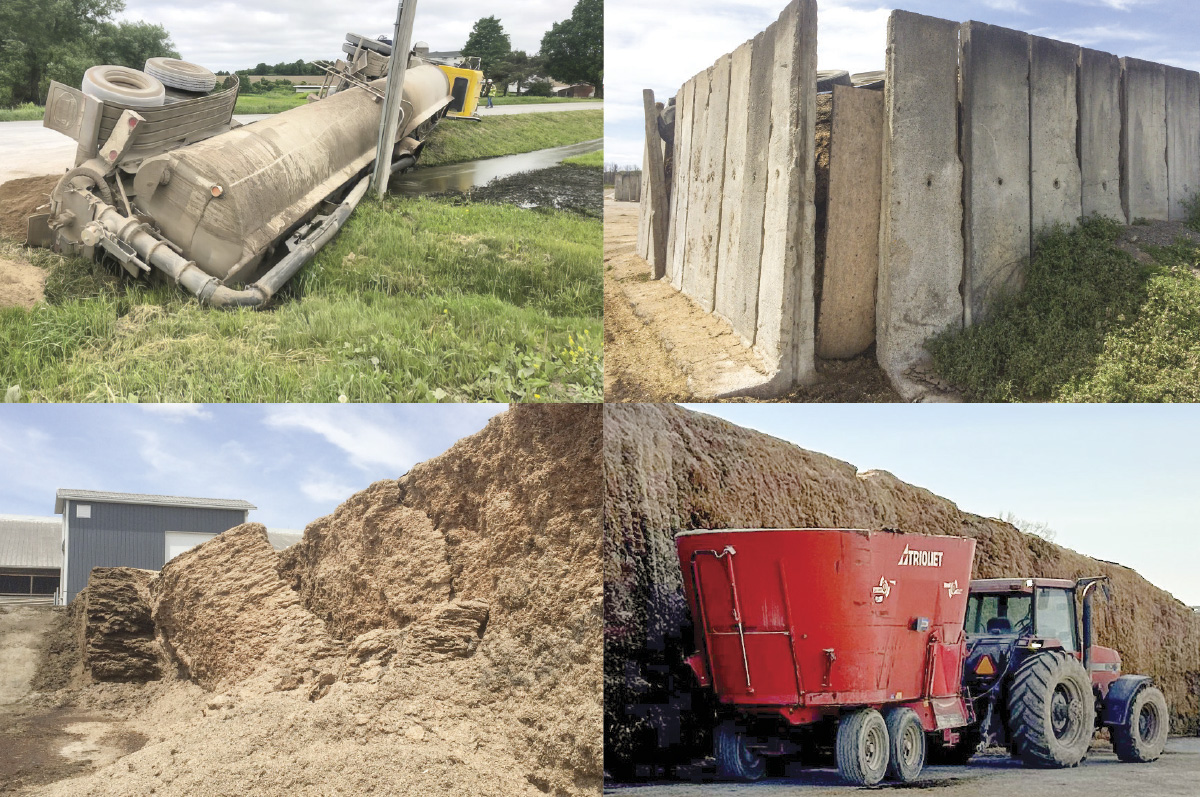Farming is not just a job. It is a way of life. Unfortunately, many dangers are associated with this vocation. Individuals on farms are exposed to a host of mechanical and environmental hazards every day that increase risk of injury or death. It is vitally important to be safe and to keep employees safe and productive. Working safely and avoiding mishaps saves money and makes your operation more efficient, but most important, everyone should go home safely at the end of the day!
TRACTORS AND MACHINERY
Tractors and large, heavy machinery are used on just about every type of farm. Approximately two-thirds of fatalities on a farm are associated with tractors and other machinery. Common types of machinery-related incidents include tractor rollovers, runovers, struck-by incidents, crushing incidents, power-take-off (PTO) entanglements, other machinery entanglements, and roadway collisions. ROPS (rollover protective structures) effectively protect the tractor operator in a rollover, limiting the rollover and creating a safe area around the operator’s seat. Call 1-877-ROPS-R4U (1-877-767-7748) or visit ROPS for assistance to install a ROPS system and receive potential rebates towards the cost. Low-cost retrofit PTO shields can be purchased from the New York Center for Agricultural Medicine and Health at Northeast Center for occupational health and safety.
-

Safety includes attention to physical infrastructure as well as day-to-day operations. Planning and maintenance are constant needs. Pictures (clockwise): overturned manure tanker, compromised bunk wall infrastructure, parking in hazardous location, silage avalanche. Photos courtesy of Joe Lawrence and Kirsten Workman.
Always pay attention to the task when working with farm machinery. Keep young children and other bystanders out of the area where machinery is being used. Farm employees should wear high-visibility clothing to prevent run-over incidents. Pre-season maintenance is critical to reduce risk and lost time during critical tasks. Always shut off machinery and wait until it stops completely before performing any maintenance or repairs. If you have to work under raised equipment, make sure it is properly locked out, or blocked up with appropriately sized jackstands.
MANAGING FATIGUE DURING THE BUSY SEASON
Being overtired can lead to injuries and mishaps. Fatigued operators are more likely to make mistakes and especially so when combined with complacency. Most people require at least seven hours of sleep for optimal performance. Too little sleep, especially over consecutive nights, can result in impaired function and significantly reduced reaction time. Workers should have water and snacks and stay well-hydrated. It is important to take breaks occasionally. Be careful about rushing to beat the weather. One farmer commented, “Productive time substantially decreases after dark.”
MANURE STORAGE AND HANDLING
Manure management can pose human and environmental safety hazards from storage and land application. Adequate volume of storage in well-maintained facilities can reduce many of these risks, allowing flexibility to prevent discharges and spreading during high-risk conditions. Often the conditions that have the highest risk for environmental damage are also the most dangerous for employee safety. Have an emergency action plan and make sure employees are trained to execute that plan.
- RESOURCE: “Manure handling emergency action plans”.
MANURE COLLECTION AND STORAGE FACILITIES
- Drowning hazards may exist, especially where farm vehicles are operated in proximity to these facilities. Use control measures like safety stops and gates at push-off ramps and unloading areas. Install signs, fences, ladders, and other devices to keep vehicles and people away from storage structures and other dangerous areas.
-
RESOURCE: “Manure storage maintenance and safety”.
- Inhalation of manure gases is possible, with the highest risks associated with pumping, mixing, agitation, and clean-out. If you witness someone being overcome by manure gas, DO NOT attempt to offer assistance without proper training and protective equipment, so you don’t become a victim yourself.
-
RESOURCE: “Manure gas safety”.
- Confined space entry training should be conducted on your farm and proper protocols should be used whenever working in or around these areas on your farm.
-
RESOURCE: “Confined space manure storage emergencies”.
- Anaerobic digesters, electric generation plants, and biogas facilities have unique safety issues related to their operation. Be aware of mechanical, explosion, voltage, atmospheric, fire, noise, spill, and other specific precautions as outlined by the Environmental Protection Agency’s guidance document.
MANURE TRANSFER AND APPLICATION
- Many farms transfer manure using pipelines or use pumps and hoses to transfer or apply manure. These systems operate under high pressure and must not be left unattended while transferring or applying material. Valves and shutoffs should be checked at least annually.
- Road safety is always important when farm equipment is operated on the road. In addition to normal roadway safety issues, farmers should be prepared to perform a spill response if a manure spreader or truck were to tip over.
-
RESOURCE: “Manure spill response and recovery”.
CROP HARVEST
Harvesting crops is often viewed as a race against the clock due to weather and stage of crop growth. Advances in animal nutrition and changing economics continue to emphasize the need for high forage quality. This increases pressure on farmers to optimize their forages, which intensifies the risk of machinery error and operator fatigue. At the end of the day, as important as our crops are to the farm, they are not worth risking human life.
While we cannot manage the weather, we can manage for the weather. Pre-season planning increases the chances of meeting forage quality goals while minimizing risk of breakdown and injury.
-
RESOURCE: “Dynamic harvest schedules”.
FORAGE STORAGE
Fermented forage (silage) is the most common form of forage for most dairy operations. Horizontal silos (bunks or piles) offer a number of logistical benefits to store large volumes of silage. However, these structures also present challenges and concerns related to forage preservation and safety. Size, particularly height, of many of these structures can present safety hazards during ensiling and feedout. Fortunately, many of the practices needed to improve preservation of feed also improve safety conditions.
Guidelines for successful preservation of silage include achieving proper forage dry matter at ensiling, high silage densities, managing slopes, staying within the defined structural footprint, and having the right sized equipment for both ensiling and feedout.
-
RESOURCE: Video “Managing for quality silage in bunk silos and piles”.
Silo gases, particularly right after ensiling, present a significant danger and while often associated with confined spaces, are known to occur around horizontal silos as well. Take extreme caution in confined spaces but be aware of your surroundings when working around any silage.
-
RESOURCE: “Silo gases – the hidden danger”.
The most significant risks at feedout are associated with falls and avalanches. Removing plastic covers and spoilage presents a significant fall risk. Following guidelines for optimum silage preservation will reduce spoilage issues.
Silage should not be piled higher than the reach of the unloading equipment to prevent undermining.
No one should ever walk near the face of the pile; avalanches can happen without warning. For safety near silage faces, best practice includes staying a minimum of three times the height of the face away.
Farm safety is everyone’s responsibility. Maintaining good protocols and providing recurring training goes a long way to keep everyone safe. Farm safety is no accident.
Farm safety and emergency planning
A comprehensive written safety program should be standard on all farms. Make sure all of your employees clearly understand the safety and health program. This is important to build a good safety culture in your organization. Owners and managers must lead by example and set the standard for all employees when it comes to safe work practices and procedures. Eliminate, reduce or guard hazards that are identified through periodic safety assessments. Take time to provide recurring safety training throughout the year. Make sure that new employees receive complete safety training before they are exposed to hazards.
Develop a comprehensive Emergency Action Plan for your farm. Your farm should be prepared for any type of emergency or natural disaster that could occur. On an annual basis, invite your local fire department out for a tour of your farm. You want your local fire department to be familiar with your facility in the event they have to come to your farm for a fire or a rescue. Create farm maps of your farmstead and buildings and share that map with your local fire department. Consider labeling or numbering buildings and include that on your farmstead map to make it easy for rescuers to get to the right building or structure. On the farmstead map you can note buildings or structures with hazardous items, such as fuel storage, pesticides, confined spaces, animals, or bulls.
• RESOURCE: “Ready AG workbook”.
 |
This article appeared in PRO-DAIRY's The Manager in July 2023. To learn more about Cornell CALS PRO-DAIRY, visit PRO-DAIRY. |






